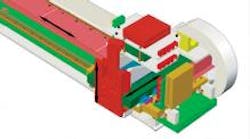Robotics Industry Focus: More Controllers, Fewer Cables
Precision-positioning applications often employ multiaxis- stage technology. These stages move objects in two, three, or more degrees of freedom including linear, rotary, tilt, and lift. Parallel kinematic drives like hexapods can easily provide six DOF quite elegantly. But in most cases, a simple arrangement of mechanically stacked stages is a reasonable and economical alternative. The downside is that cable management often becomes a problem.
Who, What, Where Authored by George Jaffe Edited by Leslie Gordon Points • Moving cables can generate particles and tend to outgas. Resources |
A relatively complex example comes from equipment for semiconductor wafer inspection. Typical systems contain a stack of XYZ linear stages — directly driven slides that provide controlled positioning along a linear axis — and a theta rotary unit for angular movement. The positioning machine can easily have 16 connectors at the final electrical terminal with over 100 wires, many of which are in constant motion during operation.
One problem associated with this arrangement is that cables bend and accelerate as the machine works. This causes undesirable temperature rise in the linear motor drives. Also, the cables’ bend resistance is not constant, so there are stick-slip and randomly distributed effects that complicate the task of high-precision positioning. Additionally, moving cables generate particles and tend to outgas, a disadvantage in clean rooms.
Moreover, the reliability of a stage system depends on the number of cables: The more cables, the bigger the risk of a failure or defect. Companies often replace moving cables during regular maintenance as a preventative measure. But this practice lengthens machine downtime and boosts operating costs. And electromagnetic interference between cables can cause cross talk, making it difficult to integrate systems. Finally, multiaxis moving-cable arrangements take up space, which also incurs a cost.
An obvious solution is to reduce the number of cables. But how, exactly? The idea is to replace the central multiaxis controller with single, separate control modules, each mounted directly to an axis. The modules connect to a high-speed bus interface, and allow interpolated movements between different stages. The bus interface, in turn, connects to the motor, encoder, and sensors through short, stationary cables. The bus interface is Controller Area Network (CAN) technology developed in 1983 for the automotive industry. CAN now also serves a broad range of safety-related applications such as aircraft and elevators.
As an example, the model DAC1005 (manufactured by LPKF) is a universal motor controller for one axis. It complies with CANopen standards (DS 301 and DSP 402) and is certified by CAN in Automation (CiA). CiA is the international users and manufacturers group in Nuremberg, Germany, that develops and supports CANopen and other CAN-based protocols.
The DAC1005 can control dc motors, as well as two and three-phase servo, stepper, and linear motors. Besides running CANopen, it can communicate with a master computer via a serial port (RS-232). All circuitry resides on relatively small PCBs so the control boxes have little mass.
Consider a three-axis XYZ linear system with two linear motors, one dc motor, and peripheral controller and cabling. There are three moving control modules, a small, three-wire, shielded CANbus cable in a daisy-chain configuration, and two wires for power. In total, the complete positioner needs just two separate 7 and 12-mm-diameter cables, independent of how many axes the stage includes. One moving cable carrier can easily accommodate the five electrical leads.
Again, each axis carries its own motion controller. All leads to motors, sensors, and encoders are typically less than 20-cm long. More importantly, electrical connections to the upper axes are static, so cables don’t bend or move. And the shorter cables eliminate cross talk and radiation problems. An external power supply replaces the typical bulky central motion controller. And to replace an axis, users just exchange the whole stage-controller combination. So individual stage information, such as PIP-controller tuning, is hardwire-connected to the mechanical structure. Parameters can be set at the factory, saving system integrators a lot of effort.
